Better Benefits, Lower Costs
Impact of COVID-19 On Your Health Insurance Rates
Impact of COVID-19 On Your Health Insurance Rates
As the end of August approaches, many employers begin to turn their attention to the upcoming renewal season for their health plans.
We will begin to receive our first renewal numbers from the health insurance companies in a couple of weeks. The question on everyone’s mind is – what impact will the pandemic have on those renewals?
The industry’s feelings on this question have evolved over the past few months. At the outset of the pandemic, health plans and brokers (including OneDigital) developed COVID-19 cost estimators in an attempt to determine the cost impact on a specific health plan based on employees’ risk for contracting a serious case of the disease. We braced for our clients to experience significant claims.
But something else happened. For most employers, health plan costs decreased and were historically low in April, May and June.
We discovered that three factors were primarily driving these lower-than-expected costs:
-
Deferral of Elective Care
With everyone being encouraged or required to stay home, Americans put off non-emergency care for as long as possible. Joint replacements and other elective care were being postponed. People were reluctant to go to the emergency room with as much frequency as they might have in the past. As a result, claims costs vanished for care that wasn’t required.
-
Telemedicine
Meeting with a doctor by telephone or video chat is not a new concept; health plans have included this service for years. But it never received much attention from members until the pandemic. Suddenly, going to the doctor’s office and sitting in the waiting room with potentially infected patients became a serious concern. Is there a way I could meet with my doctor to have this conversation without coming in physically? The answer is yes! Doctors and patients all across the country embraced this idea and telemedicine usage has seen an increase of over 5000% versus this time last year.
-
Medicare/Medicaid
The population most vulnerable to serious illness from COVID-19, the elderly and low income, are, for the most part, not covered by employer-sponsored plans. Medicare, a federal program, covers most Americans age 65 and older, and Medicaid provides health care to poor Americans through a combination of federal and state funding. So many of the serious hospitalizations during this pandemic have been paid for by a government program.
Given the decreased claim costs, many health plans have seen over the past few months, can we expect favorable renewal rates for 2021? Many employers would love to see their health insurance rates stay flat or even – dare I say it – go down?
Don’t hold your breath. Back in April, health plans were cautiously optimistic about the 2021 forecast, based on the decreased claims they were experiencing. Because the pandemic is an isolated event, underwriters would be unlikely to include its claims in their calculations, went the conventional wisdom. They were more likely to tap into their reserves than to increase rates to employers who may or may not ever experience a COVID claim. But by June, the conversation was starting to change.
Health insurance companies began to hint that there would be modest increases in 2021. The possibility of a “second wave” (or even third), of pent up deferred care, was starting to spook them. And most recently, employers are being cautioned not to expect a health insurance windfall for 2021. Even with favorable claims, insurance companies will play it safe and be reluctant to drain their reserves if losses are worse than expected next year. Because this is a very conservative industry, expect health insurance companies to deliver modest to moderate increases, even if your claims have been low this year. They will argue that we simply don’t know what will happen next year – and they are right. When in doubt, the insurance company will hedge its bets.
This is just one more reason to consider self-funding if you are able. Most of our self-funded clients have reaped the benefits of a low claims year, and that savings can never be lost, even if next year gets back to normal, or worse.
If you have not looked at self-funding recently and want to learn more, check out this blog: Self-Funded vs. Fully-Insured: Weighing the Cost Savings for Your Business.
Ready to have a conversation to see if your company may be a good candidate? Contact your OneDigital consultant today.




